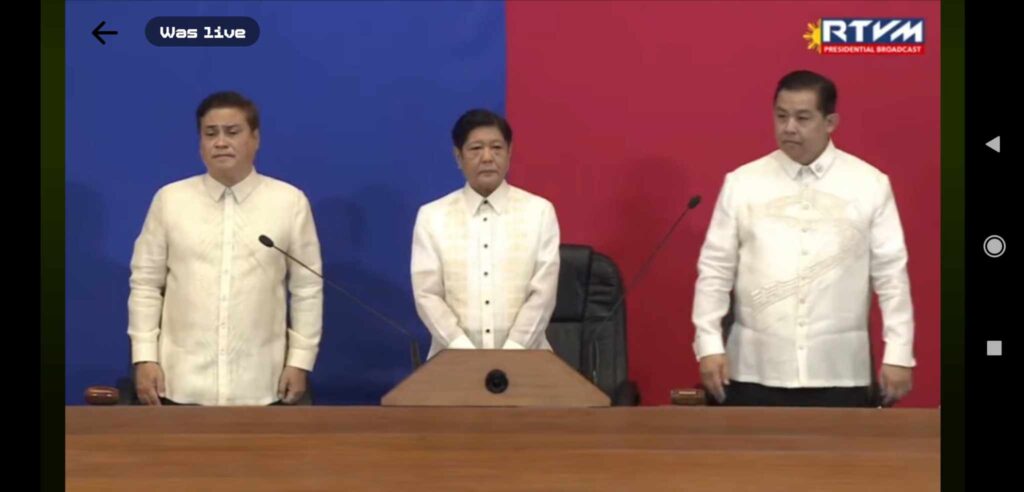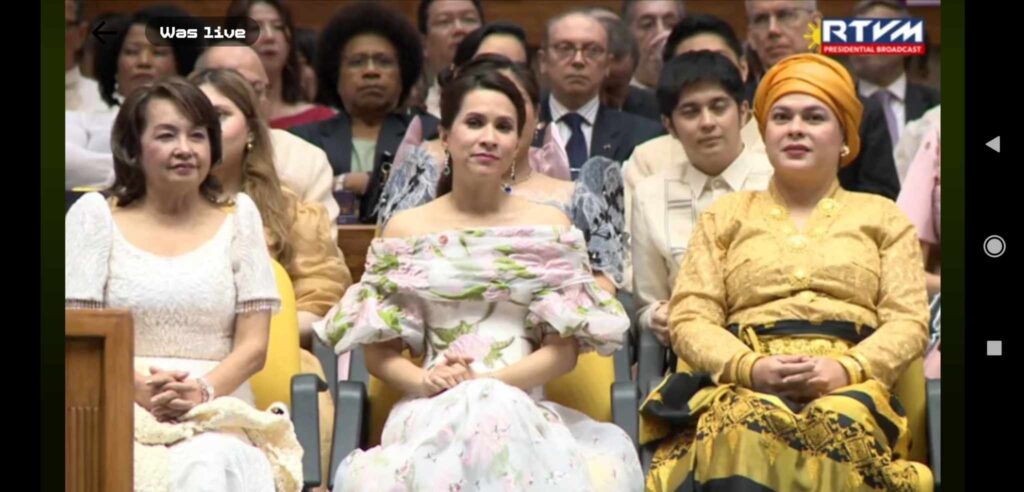“The new Philippines has arrived,” declared President Ferdinand Marcos Jr. in the vernacular, as he concluded his second State of the Nation Address (SONA). Highlighting the achievements and immediate as well as long-terms plans of his one-year-old administration, the president touched on such areas as inflation, revenue collection, food security, infrastructure, education, global competitiveness, digitalization, OFW welfare and providing support for such industries as agriculture, business process outsourcing, tourism and healthcare, among others.
By Alex Y. Vergara
Days before he was to deliver his second State of the Nation Address before senators, representatives, government officials, key allies and members of the diplomatic community at the Batasang Pambansa in Quezon City, President Ferdinand Marcos Jr. promised to provide his countrymen a “very simple” performance report of his administration’s achievements and plans.
And that was exactly what the nation got as Marcos, in a speech that lasted a little over an hour at the 19th Congress yesterday afternoon, talked about the gains and successes made by his administration is a number of key areas, including dealing with inflation, more efficient revenue collection, showpiece infrastructure projects, adherence to the rule of law, better and more affordable education for all and a “new face” in the government’s continued campaign against illegal drugs.


Speaking in a mix of English and Filipino, the president, unlike his predecessor, former President Rodrigo Duterte, stuck pretty much to the script, pausing occasionally as a highly partisan audience interrupted his speech with a series of warm applause. Although his overall tone was formal, the language he used, whether speaking in English or Filipino, was dignified, readily understandable and almost bereft of jargon.
A fair warning
Although he promised to be tough on hoarders and smugglers, warning them that their days are numbered – “bilang na ang mga araw ng mga smuggler and hoarder na ’yan” – Marcos didn’t resort to a string of expletives, which people had come to expect from SONAs past under Duterte. He also didn’t use the occasion as a national platform to single out critics and perceived enemies.


To loud applause, the president also warned wayward law enforcers and other shady characters involved in the “highly nefarious” drug trade that they have already been exposed. “I will be accepting their resignations,” he declared.
He also pledged his adherence to a “strong and stable” rule of law, citing that such a commitment will help “strengthen the foundations of transformation.”
“We will fully support the judiciary’s efforts to improve the justice system and to protect constitutional rights,” he said. “Our police and armed forces are being strengthened and modernized to be effective in maintaining peace and order and sovereignty.”


With regards to the continuing drug menace, he said, “The campaign against illegal drugs continues, but it has taken on a new face. It is now geared towards community-based treatment, rehabilitation, education and integration.”
Reformation and integration
To support this thrust, Marcos launched last year Buhay Ingatan, Droga ay Iwasan or his BIDA program, which paved the way for the establishment of an additional 102 Balay Silangan Reformation Centers nationwide.
“We will relentlessly continue our fight against drug syndicates, shutting down their illegal activities and dismantling their network of operations,” he vowed.
To further underscore certain points, the president also peppered his speech with figures. Despite a bleak global prospect with the world coming out of the pandemic, the Philippine economy, he declared, posted a 7.6-percent growth in 2022, or the highest-ever growth rate the country has posted in 46 years.
This year is also proving to be a good one, as the economy posted a 6.4-percent growth during the first quarter. At the rate the economy is growing, it is on track to reach the government’s target of six to seven percent growth in 2023.
The digital economy alone contributed P2 trillion to the country’s economy in 2022, an amount equivalent to 9.4 percent of the country’s Gross Domestic Product.

“We are still considered to be among the fastest-growing economies in the Asian region and the world,” the president boasted. “It is a testament to our strong macro-economic fundamentals.”
Robust economic growth
The World Bank, Marcos added, shares in the country’s optimistic outlook in 2023. Anchored on strong local demand and underpinned by robust consumer spending, solid jobs recovery, the growing BPO industry and steady flow of dollar remittances from OFWs abroad, the leading global monetary institution also projects the Philippine economy to grow by six percent.
Inflation, although still very much evident, is now at a manageable level, which enabled the Marcos administration to help stabilize the prices of most basic goods and “critical commodities.” With inflation hovering at 8.7 percent in January, the rate has eased up in all regions of the country, going down more than three percentage points to 5.4 percent in June, he said.
Marcos cited the Bangko Sentral, which projected inflation to further ease by the close of the year, down to 2.9 percent at the start of 2024.
“We are working earnestly to further stimulate the economy,” he said. “We are helping industries to grow. To hasten the flow of products and services, we have channeled more effort and resources to infrastructure.”
Build Better More
And infrastructure development, which is anchored on the administration’s P8.3 billion Build Better More or BBM program, now encompasses 194 projects, 123 of which were started just as Marcos assumed the presidency.
Such is Marcos’ faith on physical connectivity that his administration allocated 83 percent of the program’s resources to rehabilitate and build new roads, bridges, seaports and airports.
“Our infrastructure spending will stay at five to six percent of our GDP. The underlying logic to our infrastructure development is economic efficiency,” he said.


To overcome the country’s archipelagic topography, Marcos envisions to link the country’s tree major island groups, connecting neighboring islands with bridges and, thus, drastically cutting travel time and helping stimulate the flow of goods, services and people faster.
The 1,200-kilometer Luzon Spine Expressway Program, for instance, which will effectively connect Ilocos to Bicol, is designed to reduce travel time between the two regions from 20 hours down to just nine hours.
Under the administration’s Mega Bridge Program, 12 bridges totaling 90 kms. long will be constructed, connecting islands and areas separated by bodies of water like Bataan and Cavite, Panay Guimaras and Negros, and Samal Island and Davao City.
“As of June, we have constructed, maintained and upgraded more than 4,000 kms. of roads and 500 bridges across the country,” Marcos said.
Crucial airports and seaports have also received much-needed attention, including several piers in Cebu, new passenger terminal buildings at Clark Airport and the Calapan seaport.
The country’s railway system is also getting its fair share of resources with the planned addition of more than 1,000 kms. of railroad tracks, linking, for instance, Pampanga and Laguna, and reducing travel time between the two provinces from four to two hours.
Faith on renewables
Renewable forms of energy, he also stressed, is the way forward, touting a series of renewable energy projects funded by foreign investment, including 126 renewable contracts with the potential capacity of 31,000 megawatts.
“To date we have over a thousand projects spread all over the country. Two hundred ninety-nine of this are solar, 187 are wind, 436 are hydro-electric, 58 biomass, 36 geothermal, and 9 are ocean-powered,” he said.
During various parts of his speech, whether on making OFWs lives easier through better, faster services and the protection of their rights abroad or providing Filipino families easier access to Pag-IBIG funds to solve the housing backlog, the president returned to a recurring theme that defined his presidential campaign last year: unity or pagkakaisa.
On addressing conflict and rebellion in the countryside, for instance, Marcos, steering clear of combative and inflammatory language, expressed his belief in the effectiveness of the country’s barangay development and enhanced comprehensive local integration programs.
“I will issue a proclamation granting amnesty to rebel returnees and I ask Congress to support me in this endeavor. Our journey to progress requires not only unity and social cohesion amongst our people. It is also imperative that our nation remains intact and inviolable, our sovereignty preserved.”


Preserving country’s territorial integrity
Without mentioning China and its expansionist moves in the West Philippine Sea, Marcos vowed, “We will protect our sovereign rights and preserve our territorial integrity in defense of rules-based international order. With our national interest paramount, we would always pursue constant dialogue and diplomatic approaches to the resolutions of any issue that may arise.”
He also assured the nation that under his watch, no Filipino would be left behind.
“While we are continuously addressing the state of the economy, we are also bolstering the abilities of the Filipino through important tools like education, good health and jobs. A big chunk of government funds has been earmarked to address these. Sa ating pagtahak sa kaunlaran, walang mamayang Filipino ang maiiwanan,” (In our quest for progress, no Filipino citizen will be left behind.) he said.
Every Filipino’s life is important
“Para sa atin, ang bawat buhay ay mahalaga. Ano man ang edad, kasarian, pangkat, reliyon o pisikal na kondisyon, sila ay kukupkupin at tutulungan,” (For us, every single life is important. Whatever the age, gender, grouping, religion or physical condition, he or she would be cared for and supported.) he added.
He concluded his speech by expressing confidence in the future and praising the country’s “world-class” quality of workforce in various fields. That confidence, he continued, “has been further buoyed by the demonstration of love for the Philippines. Every Filipino has unanimously risen to the challenge that we’ve made to them to be part of the nation’s future.”
“Handa silang maghandog ng tulong dahil mahal nila ang kanilang kapwa Filipino. At mahal na mahal nila ang Pilipinas. And thus with this in my heart, I know that the state of the nation is sound and improving. Dumating na po ang bagong Pilipinas,” (They’re ready to offer help because they love their countrymen. And they love the Philippines…The new Philippines has arrived.) he ended.





